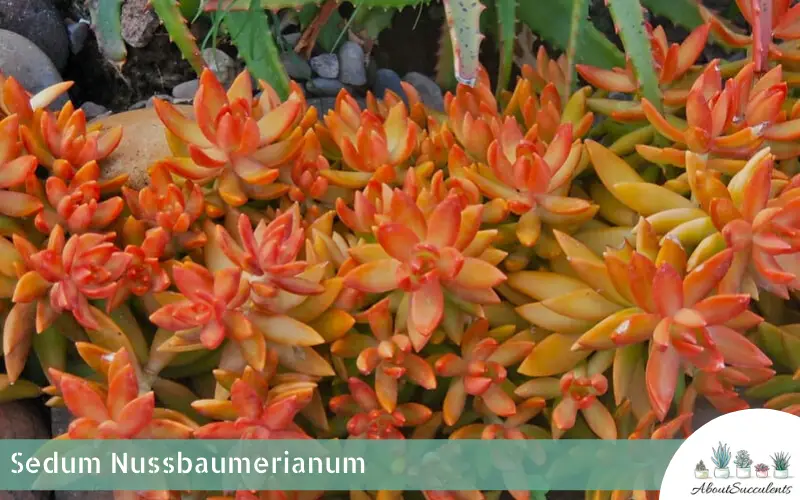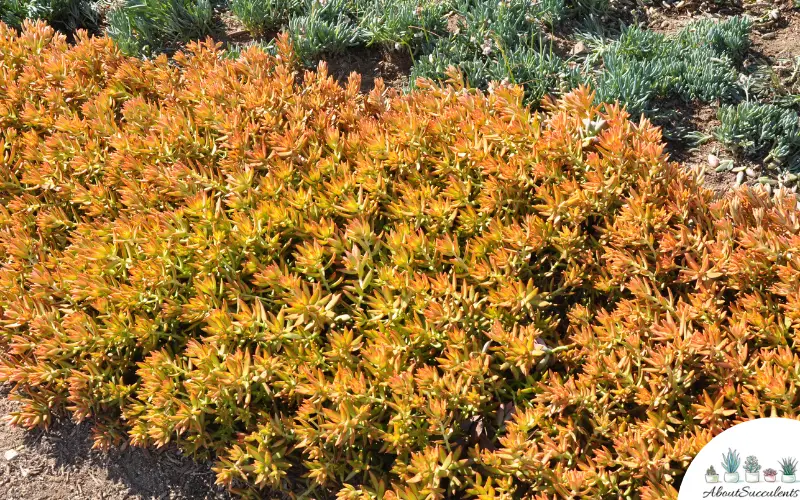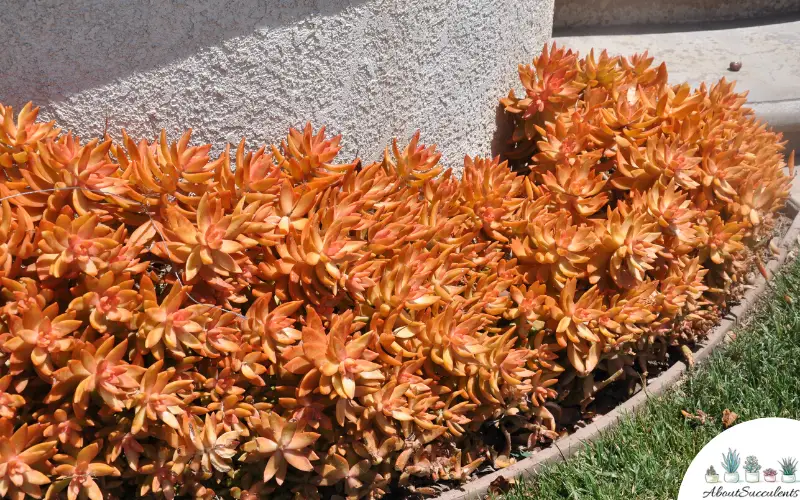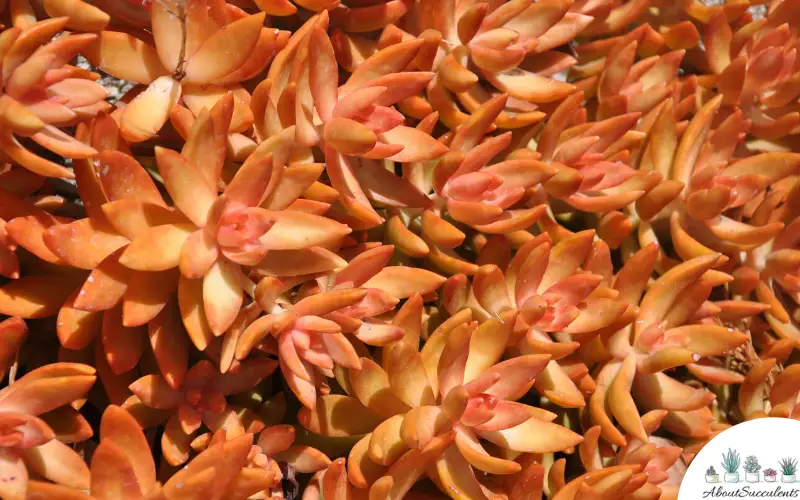
Sedum nussbaumerianum is a charming and alluring succulent that is popularly used by horticulturists as ground cover.
The succulent is given the aliases Coppertone Stonecrop and Golden Sedum because of its long and plump leaves which develop a coppery-orange color when given proper sun exposure. When only given partial sun, the leaves develop a yellow-green color.
Coppertone Stonecrop is a low-growing succulent that produces beautiful rosettes and blooms round clusters of white flowers which give out a light fragrance.
Sedum nussbaumerianum can reach a height of 12-inches (30cm) and can cover ground of up to 3-feet (91cm). It comes from the Crassulaceae family. Coppertone Stonecrop was naturalized in Italy but can be found in Mexico, New Zealand, and the Canary Islands.
General Information:
Also known as: Coppertone Stonecrop, Golden Sedum
Plant Family: Crassulaceae
Origin: Naturalized in Italy but can be found in Mexico, New Zealand, and the Canary Islands.
Height: 12-inches (30cm)
Exposure: Partial to full sunlight; 4 to 6 hours per day.
Water Needs: Water only when soil is dry to the touch, little watering during the winter and summer months.
Soil Type: Cactus soil mixed with perlite at a 2:1 ratio; 1:1 ratio if grown in more humid regions.
Soil pH: Slightly acidic (5.95 pH)
Tolerance: Drought
How to Grow and Care for Sedum Nussbaumerianum

Sedum nussbaumerianum can be grown in a garden or indoors. This type of succulent grows better outdoors because it can receive regular exposure to the sun and attain its much-sought-after copper-orange color.
1. Sunlight
If planted outdoors as ground cover, place Coppertone Stonecrop in a location that receives 6 hours of sunlight per day. You can also plant Coppertone Stonecrop in a hanging basket.
Sedum nussbaumerianum is not a cold-hardy succulent. It is best recommended to grow the plant indoors if the temperature in your region tends to drop below 30° F (-1° C).
As an indoor succulent, place Sedum nussbaumerianum near a window that receives 4 to 6 hours of sunlight every day.
2. Watering
Sedum nussbaumerianum exhibits the same watering requirements as other succulents. You should only give the succulent water when its soil is dry to the touch. Giving the plant more water than it needs will cause its roots to rot.
To find out if the soil is dry, insert a stick one inch into its topsoil. Pull out the stick. If the end of the stick is dry, water Coppertone Stonecrop until the soil is fully saturated and dripping onto the tray.
In the wintertime, the soil will stay moist much longer. You will have to cut back on the watering schedule.
3. Pot and Soil
A pot that is made of clay would work best in supporting the growth of Sedum nussbaumerianum. Clay is a porous material and allows for the proper evaporation of moisture from the soil. You should only get a pot that measures 4-inches or 10cm.
Soil is another important factor to ensure the proper growth of Sedum nussbaumerianum. You must use well-draining soil such as cactus but add perlite to further improve drainage.
The ideal ratio of cactus to perlite is 2:1. If you live in a humid region, adjust the ratio of cactus to perlite to 1:1.
How to Propagate Sedum Nussbaumerianum

Sedum nussbaumerianum is also popular with horticulturists because it is easy to propagate.
You can propagate Sedum nussbaumerianum using 3 methods: leaves, cuttings, and seeds.
Method 1 – Leaves
Step 1: Choose a firm and healthy leaf.
Step 2: Perform a clean pull which means no part of the leaf must be left on the stem. A clean pull gives you a better chance of successful propagation.
Step 3: Allow the leaf to callus or harden in a few days by placing it in a dry and shaded area.
Step 4: Place the callused leaf on well-draining soil.

Method 2 – Cuttings
Step 1: Using a sterilized and sanitized knife or garden shears, cut the stem off from the sedum cluster.
Step 2: Place the cutting in a dry area to allow it to harden.
Step 3: If the cutting has callused well enough, plant it on well-draining soil.
Method 3 – Seeds
Step 1: Plant the seeds in well-draining soil.
Step 2: Water the soil when it feels dry to the touch.
Step 3: Make sure the seeds get enough sunlight. If grown indoors, place the pot under a Grow Light
Frequently Asked Questions
Sedum nussbaumerianum is not included among plants that are toxic to cats and dogs and listed on the website of the American Society for the Prevention of Cruelty to Animals (ASPCA).
Sedum nussbaumerianum is a resilient plant but like other succulents, it can die because of overwatering.
The roots of succulent plants cannot remain in a moist environment for a long time. When the roots stay wet, they can develop an infection that can spread quickly throughout the plant.
You will have an idea if Coppertone Stonecrop is going through root rot if the leaves have changed into a yellowish or brownish color. Don’t take any chances and cut off parts that have signs of potential discoloration.
Always use a sharpened and sterilized knife or garden shears when cutting parts of the plant to prevent contamination.
Gently pull out the plant and remove the excess soil to check on the condition of the roots. Cut off all roots that are rotting and set aside Sedum nussbaumerianum to dry out.
When Coppertone Stonecrop has dried out completely, replant it in well-draining, fresh soil.
In the springtime, Sedum nussbaumarianum blooms small, white flowers that emit a slight fragrance.
Last Updated on June 10, 2022 by Sofia Lara